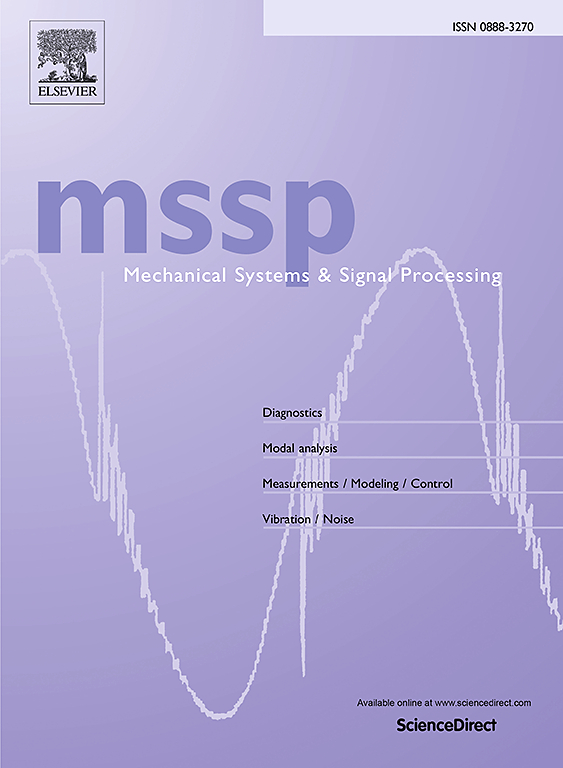Fault-relevance-based, multi-sensor information integration framework for fault diagnosis of rotating machineries
IF 7.9
1区 工程技术
Q1 ENGINEERING, MECHANICAL
引用次数: 0
Abstract
In a multi-sensor system for fault diagnosis, each sensor’s data may contain a different amount of fault-related information, due to different transfer paths of a fault signal to each sensor. Previous research has exploited fault feature analysis to fuse multi-sensor data or simply stacked channels of data for deep learning input, entrusting the information integration task. However, existing methods are hard to identify which sensor’s data dominantly contain fault-related information, since the characteristics of all the sensors’ data gradually get mixed up as the data propagating from input to output converge through the neural network layers. Consequently, the information integration task may not scrutinize the significance of each sensor’s data (i.e., fault relevance), resulting in information loss. Therefore, this paper proposes a multi-sensor information integration framework that accounts for fault relevance of each sensor for fault diagnosis of rotating machineries. Inspired by the mechanism of a convolutional neural network (CNN), which extracts similar recurrent features in an image by the shared identical convolution kernel (the stationarity) while preserving the spatial information (the locality), a novel kernel manipulation strategy is suggested to generate a multi-sensor feature map. In the proposed method, each sensor’s data share an identical convolution kernel (the stationarity), while the unique characteristic of each sensor’s data is preserved by depth-wise convolution (the locality). Then, a sensor priority evaluation module is designed to weight fault relevance of each sensor, rather than the channel itself. Finally, an averaged attention score is multiplied by the multi-sensor feature map, thereby resulting in a fault-relevance feature map. Two experimental validation results show that the multi-sensor information is appropriately integrated proportional to the amount of the fault-related information in each sensor’s data. It is also confirmed that the proposed method outperforms existing multi-sensor fault diagnosis methods.
基于故障关联的旋转机械故障诊断多传感器信息集成框架
在用于故障诊断的多传感器系统中,由于故障信号到每个传感器的传输路径不同,每个传感器的数据可能包含不同数量的故障相关信息。以往的研究利用故障特征分析融合多传感器数据或简单堆叠通道的数据进行深度学习输入,赋予信息集成任务。然而,现有的方法很难识别哪些传感器数据主要包含故障相关信息,因为随着数据从输入到输出的传播,通过神经网络层的收敛,所有传感器数据的特征逐渐混合。因此,信息集成任务可能不会仔细检查每个传感器数据的重要性(即故障相关性),从而导致信息丢失。为此,本文提出了考虑各传感器故障相关性的多传感器信息集成框架,用于旋转机械的故障诊断。基于卷积神经网络(CNN)通过共享相同的卷积核(平稳性)提取图像中相似的循环特征,同时保留空间信息(局域性)的机制,提出了一种新的卷积核处理策略来生成多传感器特征映射。在该方法中,每个传感器的数据共享一个相同的卷积核(平稳性),而每个传感器数据的独特特征通过深度卷积(局部性)得到保留。然后,设计了传感器优先级评估模块,对每个传感器的故障相关性进行加权,而不是通道本身。最后,将平均注意力分数乘以多传感器特征图,从而得到故障相关特征图。两个实验验证结果表明,多传感器信息与每个传感器数据中故障相关信息的数量成比例地进行了适当的集成。该方法优于现有的多传感器故障诊断方法。
本文章由计算机程序翻译,如有差异,请以英文原文为准。
求助全文
约1分钟内获得全文
求助全文
来源期刊

Mechanical Systems and Signal Processing
工程技术-工程:机械
CiteScore
14.80
自引率
13.10%
发文量
1183
审稿时长
5.4 months
期刊介绍:
Journal Name: Mechanical Systems and Signal Processing (MSSP)
Interdisciplinary Focus:
Mechanical, Aerospace, and Civil Engineering
Purpose:Reporting scientific advancements of the highest quality
Arising from new techniques in sensing, instrumentation, signal processing, modelling, and control of dynamic systems
 求助内容:
求助内容: 应助结果提醒方式:
应助结果提醒方式:


